


 Overview
OverviewThis is a high score save for Time Pilot and Gyruss. Time Pilot was one of my favorite games
growing up, and Gyruss is just a fantastic game, so they were the obvious choices (for me)
to start the Konami high score save project. So why are these two games together?
Simply because the similarities in hardware allowed me to combine the high score saves for them.
That's right, one ROM works in both games, and for all known versions (Konami, Centuri, and bootlegs).
[Update:2/22/04] The ROMs for the Atari version of Time Pilot have been dumped
(thanks to Chris Hardy), and I've added support for it in this score save.
You just pop the new ROM in the existing extra socket on the board (Konami used this for a "test chip"),
replace one RAM chip with a non-volatile RAM, and your scores are saved! The only thing preventing
this from being a 30 second upgrade is that the RAM chip you need to replace is unlikely to be socketed.
You'll have to remove the RAM and install a socket for the new NVRAM. If you don't have the soldering
skills to do this, please find someone who does to do it for you. An experienced tech can do the job
in under 10 minutes. You perform these modifications AT YOUR OWN RISK!!!
 How It Works
How It WorksThe first thing these two games do when they boot up is look to see if a test chip is installed,
and if so, run that code. So I've taken advantage of this and re-written the boot routines to run in
that space. The new routines protect the high score RAM from being initialized and overwritten with
defaults. Once the high scores are safe, I jump back to the appropriate place in the original code.
No changes are made to the original ROMs. I added the ability to reset the high scores by dipswitch
selection. On Gyruss I chose an unused dipswitch, switch 8 on SW3. Time Pilot doesn't have any extra
switches so I chose an unlikely combo to do the reset; all SW2 switches ON except for switch 3
(cocktail mode). If the high score table is found to be corrupt (like when you first install the NVRAM)
it is automatically reset. Here are what the tables look like when reset:
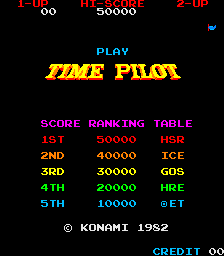 | 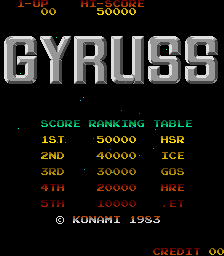 |
 Installation
Installation Time Pilot
Time Pilot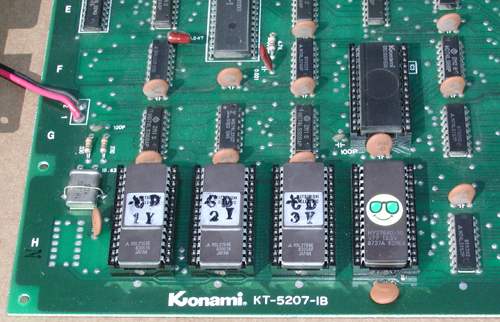
The existing program ROMs (2H, 3H, and 4H) are left intact. The new guy is wearing shades. 8)
2) The 2K static RAM at location 9F needs to be replaced with a
non-volatile memory. If that chip happens to be socketed (I haven't seen them socketed on legit boards,
only bootlegs) then this step will be a breeze; just pop out the RAM and plug in the NVRAM. If not,
then you'll have to remove the chip and install a socket. Don't try to save the chip you are removing...
2K SRAM (6116, 2128, etc.) is still very cheap (~$1), so risking damage to your board is foolish. Just
snip the legs at the body of the chip, pluck them out one at a time with your soldering iron, clean out
the holes using a solder-sucker or soldering wick, and solder in a 24-pin socket. These Konami boards
are pretty easy to work on, so you don't have to be a soldering expert to pull this off. Here's what it
looks like with the socket installed:
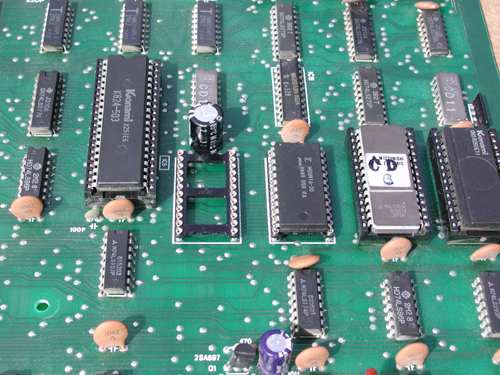
Now you need to plug in the NVRAM. You could use a battery-backed SRAM like the Dallas DS1220 or the
ST M48Z02 (or M48Z12). Or you could use a newer technology that doesn't rely on batteries, like the Simtek 25C48 or the ZMD U63716
[NOTE: these two chips have been out of production for several years, and are no longer available],
which have a 100+ year data retention. So they're good for life! Here's the board with a Simtek NVRAM installed:
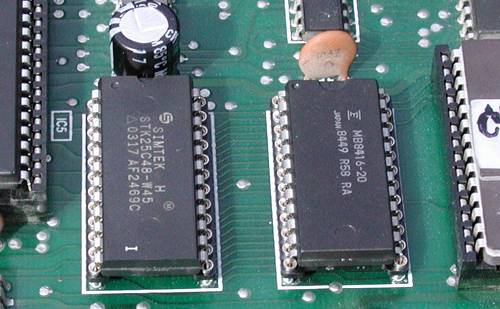
3) This step is optional (and only pertains to the Simtek NVRAM). You probably noticed the electrolytic capacitor
(~100uF to 220uF, rated 16V or higher) right above the NVRAM (I've pulled out the 104Z ceramic cap and put
the electrolytic in its place).
If the power supply cuts out too fast on power down the NVRAM may not have enough time to complete its autostore operation.
My thought was that adding this capacitor may give the chip just a bit more time to store the data to its non-volatile
memory on power down. In my experience this rarely seems to help, so I do not suggest this and I no longer
include a cap with my kits. Problems with the autostore are typically rectified by changing the switching
power supply (older style switchers work best).
 Gyruss
Gyruss1) The new high score save ROM installs in the socket at 14J
on the CPU board:
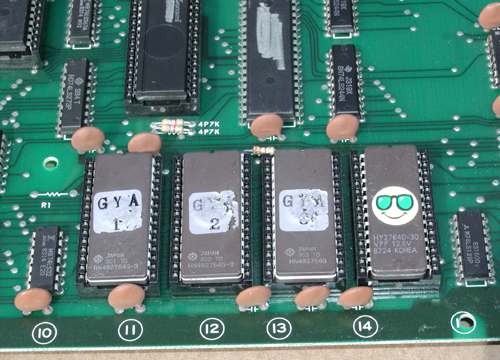
2) The NVRAM goes in location 3J (the RAM in the middle):
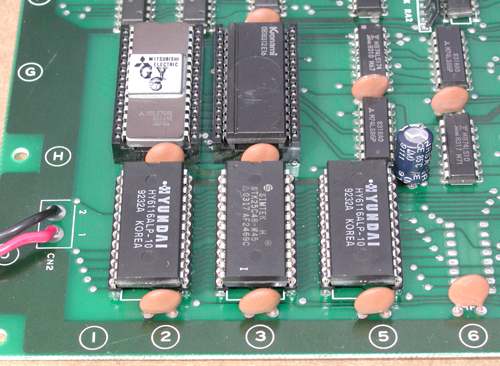
3) Optional capacitor. I installed it at the top-right of the RAM at 5J (location is not critical,
just put it in the vicinity of the NVRAM).
What about bootleg boards, you ask? There are several different kinds out there, and some may not have the
extra ROM socket installed, so you'll have some extra work to do (best thing to do is hack the board to accept
a single 27256 EPROM that contains all the program code). RAM is likely to be socketed, so you luck out there.
I don't have any bootleg Gyruss boards on hand right now, but I do have a single-board bootleg of Time Pilot
(a "Space Pilot" before I reprogrammed it with the Konami ROMs) which I succesfully installed the high score save on.
For a crude pic of the board layout that shows the ROM and RAM locations
click here.
 Kits
Kits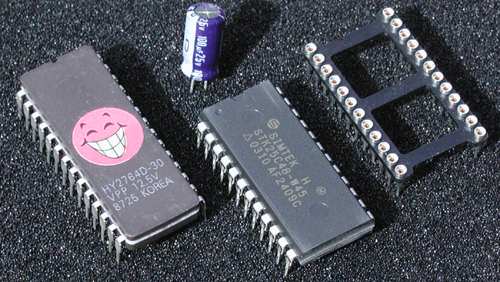
Price is $32 shipped in the US (international shipping available at additional cost).
Please email me to check availability before sending money.
 Download
DownloadFor the do-it-yourself'er. If you've got your own programmer you can just download this ROM image
and burn it to a 2764 EPROM.

Donations are always appreciated.
Buy me a beer (or two) to encourage further score save development. Thank you.